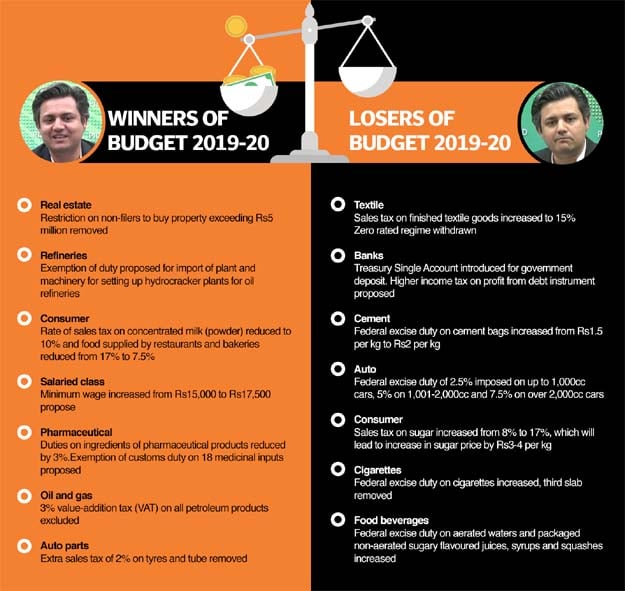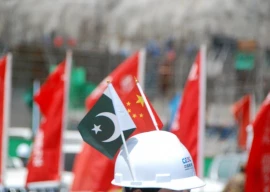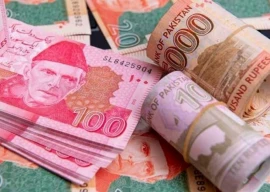
The proposed budget has a mark of the International Monetary Fund (IMF) on it that forced the Pakistan Tehreek-e-Insaf (PTI) government to take highly unpopular steps that might erode its political capital.
The government admitted in the budget documents that because of tough budgetary measures the economy will grow at a rate of only 2.4% in next fiscal year, while the inflation will hit 13% – the scenario that is contrary to what Prime Minister Imran Khan had promised before coming into power.
The 13% inflation rate means that the State Bank of Pakistan (SBP) will increase interest rate to over 15%, stifling economic growth prospects.
PM Imran to form ‘high-powered commission’ to probe massive increase in Pakistan’s debt
Contrary to the announcement, the government could not give an austerity budget and every institution got an increase in their allocations.
But the government did announce some symbolic measures like cutting the cabinet members' salaries by 10% and denying increase in salaries to grade 21 and 22 civilian officers.
The proposed size of the new budget is Rs1.8 trillion or 34% higher than the original budget of the outgoing fiscal year.
But the real challenge will be the implementation of the budget, as its success hinges upon the Federal Board of Revenue's (FBR) ability to achieve a challenging Rs5.550 trillion tax collection target.
The failure in achieving the target would mean reversing the first step that the government has taken towards addressing the core issue of high indebtedness.
The primary reason for the bloated size of the budget is a massive surge in the debt servicing cost that has been estimated at Rs2.89 trillion as against the original allocation of Rs1.62 trillion for the outgoing fiscal year. The debt servicing cost has jumped by a record 78% within a year.
The debt would eat up 41% of the budget. Instead of targeting to reduce the budget deficit, the IMF has placed a condition of primary deficit that allows unrestricted spending on debt servicing.
PTI govt slaps Rs516b ‘unprecedented’ taxes
The budget does not immediately address issues such as economic slowdown, growing jobless rate and even the high budget deficit in the next year. However, the government has taken first step towards addressing the issue of debt trap by focusing on primary deficit.
The budget deficit is projected at a record 8.2% of Gross Domestic Product (GDP) or Rs3.6 trillion. There has never been this much black hole in the federal budget that will be filled by taking Rs1.8 trillion net foreign loans, Rs1.3 trillion domestic loans and Rs423 billion provincial cash surplus.
After including the provincial cash surplus, the overall budget deficit has been projected at Rs3.2 trillion or 7.2% of the GDP, which is higher than the level left behind by the previous Pakistan Muslim League-Nawaz (PML-N) government.
It has never happened in the history of the IMF programme, where the budget deficit target will be higher than the previous fiscal year. But as the primary deficit – calculated after excluding cost of debt, would turn into surplus the government would be out of the vicious cycle of taking loans to repay the interest on loans.
Minister of State for Revenue Hammad Azhar presented the first full year and otherwise the third budget of the PTI government. Former finance minister Asad Umar had presented two mini-budgets in the outgoing fiscal year.

Azhar appeared confident while presenting the budget, although he delivered his first budget speech behind a human shield after opposition parties began protest in front of Speaker's dice. The opposition members had gathered in front of Azhar's podium.
Due to noise made by the opposition, the Minister's speech was inaudible. The opposition members chanted slogans "Go Niazi Go, IMF-dictated budget unacceptable" while reminding Prime Minister Imran Khan about his "broken promises" to give jobs and construct 5 million homes.
In the budget, the takes some very tough policy measures, increasing the tax burden of the salaried, business and corporate classes and imposing indirect taxes that will stoke inflation. As a result of these measures, every notable consumer good price will rise and the people's disposable income will reduce.
The government has reduced the income tax exemption threshold from Rs1.2 million to Rs600,000 annually. It increased maximum individual income tax rate to 35%, slapped additional custom duties of 7% on more than 2,400 tariff lines and introduced sales tax on every important item.
A modest 4.7% increase in defence budget proposed
However, the minister of state claimed that these measures were necessary to address macroeconomic imbalances. "We have brought a new thought, new commitment and new approach to governance," Azhar said as he began his budget speech.
"We are together here at this difficult time. Let us recall the economic situation the government has faced since coming into power," he said, blaming the government's arch rival, PML-N.
Azhar said that the government's priority for the next fiscal year was to increase tax revenue, with the target set at Rs5.55 trillion for the FBR. "We will increase our tax net...Benami and non-registered assets will be brought into the net," he added.
Azhar said that the minimum monthly wage has been increased to Rs17,500. He also announced that federal government employees from grade 1-16 will get 10% increase in their salaries, whereas those from grade 17-20 will see a pay raise of 5%.
The government denied increase in the salaries of grade 21 and 22 officers. Azhar also announced a 10%, increase in the salaries of the armed forces, irrespective of their grades.
The government also took some inflationary tax measures such as the 5% additional custom duty on over 2,400 tariff lines. The effective custom duty rate for the highest slab is now 27%, which will increase the prices of all finished goods, including agriculture machinery.
The government has also increased the tax rates on cement by Rs0.5 to Rs2 per kg. Up to 7.5% federal excise duty on cars has been imposed. The duty-free import facility of one mobile in a year has also been withdrawn. The sugar, edible items, cooking oil, home appliances would become expensive.
Budget outlay
Azhar announced that the size of the budget will be Rs7.0.36 trillion – higher by Rs1.79 trillion or 34% over the Rs5.24 trillion original size of the budget for the outgoing fiscal year. About 67.4% of the budget has been allocated for defence and debt servicing.
It is the highest ever outlay of the federal budget that contradicts the government's claim of reducing expenditures. The current expenditures are estimated at Rs6.2 trillion for the new fiscal year, which is higher by Rs2 trillion or 48% over the outgoing fiscal year.
The development budget is Rs701 billion and Rs85 billion is allocated for other development expenditures. The government has proposed Rs1.152 trillion for regular defence budget, which is higher by Rs52 billion or 4.7% over the original budget of Rs1.1 trillion.
Another Rs308 billion has been given for Armed Forces Development Programme, Rs327 billion for military pensions and Rs65 billion for security enhancement in tribal areas. A sum of Rs84 billion has been proposed for other security packages.
The budget documents showed that the total defence budget is proposed at Rs1.9 trillion or 27% of the proposed Rs7.036 trillion total budget. The total defence spending is higher by 11% or nearly Rs200 billion over the outgoing total spending.
Another amount of Rs2.89 trillion or 41% of the proposed budget has been earmarked for the debt serving. The original debt servicing cost in the outgoing fiscal year was Rs1.62 trillion, which has now jacked up by Rs1.3 trillion or 78% for the next year.
Azhar proposed Rs701 billion for the Public Sector Development Programme (PSDP), which is Rs229 billion less than the Planning Ministry printed in its document of PSDP for 2018-19. For running the civilian government, the federal government has proposed Rs431.2 billion, down from Rs463.4 billion in the outgoing fiscal year.
Another main expenditure was on account of pensions, including military's, as the government proposed Rs421 billion for pensions as against Rs342 billion in the outgoing fiscal year. The pensions will consume 6% of the proposed budget.
For subsidies, the government has proposed Rs271.5 billion as against Rs174.7 billion in the outgoing fiscal year. For the Benazir Income Support Programme Rs180 billion is proposed against Rs124 billion in the outgoing fiscal year.
The government has proposed the FBR's tax collection target at Rs5.550 trillion and non-tax collection target at Rs894.5 billion. The four provinces will get Rs3.254 trillion as their share in the federal tax collection under the Seventh National Finance Commission (NFC) Award.



1730360426-0/Menendez-Brothers-(2)1730360426-0-165x106.webp)



















COMMENTS
Comments are moderated and generally will be posted if they are on-topic and not abusive.
For more information, please see our Comments FAQ